Types Of Pumps & Their Applications
Water pumps come in different shapes, sizes, energy requirements, and technologies. The type of pump you choose would depend on your needs, and your ability to pay for it. A pump may run on energy ranging from zero watts, to several kilowatts. It may surprise you to learn that you can pump water from a well up to 30ft on zero energy. Below are the descriptions of different types of pumps, to help you make a choice.
Siphon Pump - Siphons move liquid without requiring any energy source. A siphon can be just a simple hose, with water sucked into it (primed) to get it started. A siphon can also be an elaborate solution that moves a good volume under high pressure. Check out these youtube channels: Learn for Life, Learn for Ideas. As long as there is water, and no bubbles in the pipes, a siphon can run forever.
Bilge Pump - moves high volume of water, but at low pressure. Cannot lift water.If you are looking for a low-cost way of moving a high volume of water, a Bilge pump may be the answer. For example, I have seen a 12 Volt 14A Bilge Pump that can move 14,000 Liters per hour. That is only 168 watts! These pumps can be easily run on solar panels only. The only problem is that Bilge pumps cannot lift water, e.g. out of a well. The chart below shows the correlation between water volume and height.
The chart shows inverse proportion between height and water volume. As height increases, the volume of water decreases. The most powerful pump at 27ft outputs no water. The same pump at 0ft is delivering 15,140 liters per hour.
Diaphragm pump - moves lower volume, but under high pressure. Cannot lift water.
Great for power car washing, jet spraying, sandblasting, water sprinklers, etc.
If you are looking to boost output pressure, this is the pump to choose.
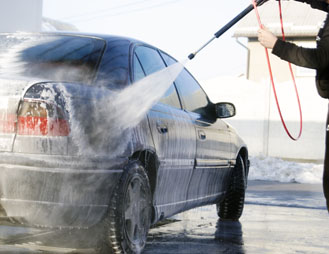 |
 |
 |
 |
Double Diaphragm pump - for moving thick liquid, and it is tolerant of debris.
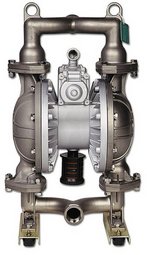 Double diaphragm pump can be air or electric operated.
An air compressor is needed when operating with air.
Double diaphragm pump can be air or electric operated.
An air compressor is needed when operating with air.
Centrifugal pumps - High pressure surface pump

 We looked earlier at Diaphragm pumps for getting high pressure output.
Let's assume you need higher water flow, or you need to pump water from shallow well, use these centrifugal pumps.
They consume more power of course, and run on AC power.
Here are specs from a typical centrifugal pump...
Max Capacity: 3M3/H (3,000 liters/hour)
Max Head: 34m
Suction: 8.5m
Power: 370W
Voltage: 220V/50HZ
IMPORTANT: Since this is an induction motor, the pump needs more power to start up.
So even though the running power is 370W, the start-up power could be five or more times.
The start-up power could be reduced by using a Soft starter, or Hard starter.
We looked earlier at Diaphragm pumps for getting high pressure output.
Let's assume you need higher water flow, or you need to pump water from shallow well, use these centrifugal pumps.
They consume more power of course, and run on AC power.
Here are specs from a typical centrifugal pump...
Max Capacity: 3M3/H (3,000 liters/hour)
Max Head: 34m
Suction: 8.5m
Power: 370W
Voltage: 220V/50HZ
IMPORTANT: Since this is an induction motor, the pump needs more power to start up.
So even though the running power is 370W, the start-up power could be five or more times.
The start-up power could be reduced by using a Soft starter, or Hard starter.
Water Pressure booster If you need higher pressure, just search online for "pump pressure booster". You fit the pressure booster to your pump's outlet.


Of course, these boosters can be connected to any water source, e.g. your faucet. Let's say your building's water pressure is low, you can boost it from the main inlet. You can also boost the pressure for one faucet by connecting the booster to the faucet.
How to increase water pressure for free - No pressure booster, or pump required https://www.youtube.com/watch?v=L3vLEjraHzI. https://www.youtube.com/watch?v=2O6LTaPj18Y.
Submersible, high lift pumps - for deep wells and boreholes
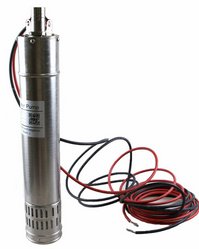 DC (Solar pumps), AC pumps
When water needs to be lifted to great heights, such as pumping water from a deep borehole, these types of pumps are used.
They are cylinderical, and spin at great speeds.
The depth of a typical borehole can range between 30-320 meters. Boreholes can be deeper in some areas.
DC pump
Solar panels are connected directly to power the pump.
No need for batteries, charge controller, or inverter.
Cost:
I ordered a 120m, 3,000L/H pump from China for US$350.
The cost of the 60m version was $230.
Power:
To power this pump, I installed 8x 250W solar panels.
4x in series. Another 4x in series.
Then the two arrays connected in parallel.
AC pump
Powered by mains electricity, or fuel generator.
AC pumps can also be powered by solar, but the DC volt must be converted to AC.
It would require batteries, and charge controller, and inverter. These are expensive solutions.
Inverter in particular is not a cheap equipment. Batteries too expensive.
To power a 1.5hp AC pump, would require at least a 5kW inverter.
DC (Solar pumps), AC pumps
When water needs to be lifted to great heights, such as pumping water from a deep borehole, these types of pumps are used.
They are cylinderical, and spin at great speeds.
The depth of a typical borehole can range between 30-320 meters. Boreholes can be deeper in some areas.
DC pump
Solar panels are connected directly to power the pump.
No need for batteries, charge controller, or inverter.
Cost:
I ordered a 120m, 3,000L/H pump from China for US$350.
The cost of the 60m version was $230.
Power:
To power this pump, I installed 8x 250W solar panels.
4x in series. Another 4x in series.
Then the two arrays connected in parallel.
AC pump
Powered by mains electricity, or fuel generator.
AC pumps can also be powered by solar, but the DC volt must be converted to AC.
It would require batteries, and charge controller, and inverter. These are expensive solutions.
Inverter in particular is not a cheap equipment. Batteries too expensive.
To power a 1.5hp AC pump, would require at least a 5kW inverter.
How to Increase Water Pressure - From main pipe coming into a house. Video on house water pressure.
Tractor-Driven PTO Irrigation Pump - These are attached to a tractor's PTO shaft.
 The pump has no engine of its own. So they are low-maintenance, and can last forever.
PTO pumps can also pump an incredible amount of water.
This example pumps 23,000 Liters per minute.
Another example.
The pump has no engine of its own. So they are low-maintenance, and can last forever.
PTO pumps can also pump an incredible amount of water.
This example pumps 23,000 Liters per minute.
Another example.
Manual Hand and Foot pumps
 |
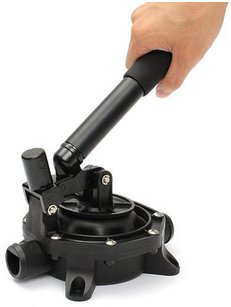 |
 |
| Hand pump | Hand pump | Foot pump |
Air pump - used for aquarium aeration, for introducing bubbles (oxygen) into water.

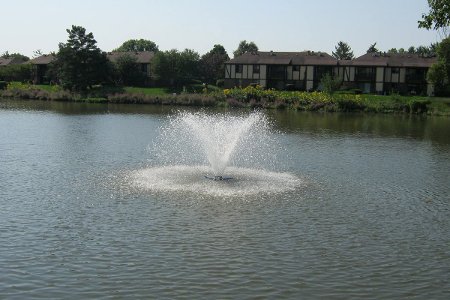 The pump only pumps air. So it is a simple machine that can last many years.
It works silently.
Low power, and energy-efficient. Can easily run with solar.
If you have a fish tank (big or small), this is a good way of keeping the water oxygenated at a low cost.
The pump only pumps air. So it is a simple machine that can last many years.
It works silently.
Low power, and energy-efficient. Can easily run with solar.
If you have a fish tank (big or small), this is a good way of keeping the water oxygenated at a low cost.
Circulating pump - for moving fluid continuously in a closed loop.
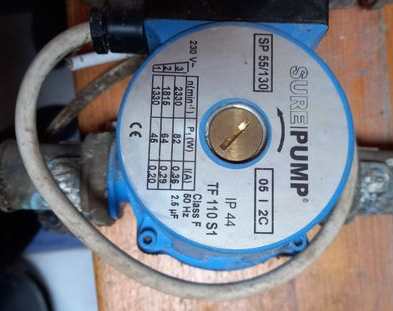
Does not lift water, and so runs on low power. In a typical home, used to circulate hot water, so that hot water would be available on demand. It can also be used to circulate the fluid in a geothermal system. Other applications are water heater, fish tank, etc.